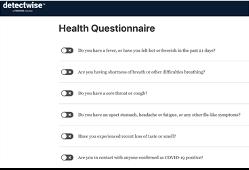
8 minute read
Technology Aids in the Protection of High-Risk Healthcare Recipients and Providers by Parsons
Technology Aids In The Protection Of High-Risk Healthcare Recipients And Providers.
To protect patients, residence, and health workers, healthcare providers and senior living centers are taking extra measures to protect those at high risk of COVID-19. One of these measures is to screen entry into hospitals, senior centers, and other treatment centers. Given the high risks associated with these facilities, it is imperative that access is based on a risk assessment as it relates to any pathogen with distinctive symptoms. Currently, the general state of access control technology is comprised of an individual with a digital thermometer and a clipboard, taking the potential entrants’ temperature and asking risk assessment questions. This laborintensive process exposes the screener to potential COVID-19 risks and is subject to human errors in recording temperature measurements and data retention.
Kiosk Technology
Kiosks, which measure body temperature and have the capability to question potential entrants, are replacing the need to have an attendant at every entry point. Touchless kiosk technology is deployed to prevent potential disease transition through surface contact. Kiosks require no physical contact and eliminate both the potential for disease transfer and the need for sanitizing between individuals. Without touchless kiosks, the reverse effect is created: a bottleneck where all individuals are subject to interacting in the same place.
Kiosks are deployed with an array of cameras and thermographic imaging devises to measure core body temperature. A common misconception is that skin temperature is the same as core body temperature. As the individual approaches the kiosk, a camera detects the individual and messages the individual to approach or step back to allow the thermographic imaging to be completed. The imaging takes between one and three seconds.
For accurate and repeatable core body temperature measurements, the temperature resolution and integration of the sensor matters. Contactless medical thermometers may use sensors which are as low as 16 temperature pixels. Obtaining the core body temperature requires data from specific regions of the face. If the administrator does not target the correct area, the measurement may miss elevated febrile skin. Taking a temperature reading from the correct location on a face is critical to ensuring reliability. Less technologically advanced kiosks use inexpensive, low resolution sensors to perform core body measurements.
DetectWise
An accurate technology solution must be able to detect specific regions of interest on a human face. Parsons’ advanced DetectWise kiosk integrates a thermographic image with a high-resolution visual image to accurately locate facial regions of interest like an individual’s tear duct or the area where supraorbital blood vessels are closest to the individual’s external skin surface. This ensures that the core body temperature assessment can differentiate between surface skin temperatures and true core temperature.
In order to provide accuracy to the 0.1 degree C every time, the DetectWise kiosk continually measures surrounding ambient Innovative technology is allowing the screening process to become automated using touchless kiosks with badge printers and cloud based hosted platforms. Kiosk technologies can eliminate or minimize the need for manned entry points thereby allowing the redeployment of resources and minimizing the risk of exposure to the screener and facility. A badge printer provides physical proof at the facility that an individual meets the access risk threat level. Finally, a cloud- based hosted platform provides questionnaire screening that both prevents at risk individuals from entering the facility and expedites entry for those individuals meeting the access risk threat level.



Figure 1: Moving from handheld devices to automated core body temperature thermographic kiosk sensors.

Elenium Sensor Array (100k temperature pixels) XVGA Higher resolution sensors are able to detect more temperature points on a human face to an area of interest like a human tear duct in an area 2-3mm² in size from 0.5 meters away.

Chino Corp., Japan Thermopile Array (2.2k temperature pixels) 48x47 pixels Low cost sensors rated for technically -/+ 0.5 accuracy will not have the capability to return values specifc enough to a location on a human face, resulting in high false negative rate.
Figure 2: Comparison – High Resolution vs. Low Resolution Sensors
1-to-1 Framing Forehead

Figure 3: Detection of specifc Facial Regions is Key to an Accurate Solution
temperature while actively and algorithmically reducing temperature drift, which increases the accuracy of the sensor temperature. The level of monitoring provided by DetectWise assures that drift is always within the 0.1 degree C limit which eliminates the need for periodic manual calibrations required by lower end kiosks.
To replace the human screener, the kiosk must be able to present all questions in multiple languages and allow a response input. While a touch screen kiosk can meet this simple requirement, it also exposes the possibility of contamination of the touch screen and COVID-19 transmission via surface transfers. To help prevent surface transfer, we have deployed touchless question response mechanisms. This can take the form of voice recognition or a screen cursor which tracks the user’s head and eye movement. Noise cancelling technologies are used with voice recognition to provide a better analysis of a user’s input. Cursor control, which follows the individual’s head and eye movement, has been found to be a preferred entry mechanism for entry points with mid to high levels of background noise. These technologies’ yes and no questions are composed to allow binary responses to collect risk assessments associated with contacts, any COVID-19 testing, other symptoms, and travel as examples. This prevents screeners from interfacing with people entering a facility. Those entering the facility can answer questions without physical interaction with a kiosk.
An additional function that a human screener performs is the exclusion of individuals who are determined to have an elevated risk profile, through either core body temperature or the answers to the questionnaire. The kiosk screening relies on the integrity of the person entering with additional technical implementations to perform remote elevated risk identification. The implementation of a remote alert sent to a station near an entry point allows human intervention in the event of an elevated risk assessment. The kiosk can utilize a printed “PASS” sticker with a time and date which must always be worn by any individual entering the facility. Barcodes can be printed on the badge for validation within the facility. Finally, the kiosk and associated cloud application can be interfaced to door controls and access controls to block entry in the event of an elevated risk assessment.
Our DetectWise kiosk meets the stringent requirements to replace or diminish the need for human screeners while keeping our most critical population protected. DetectWise was developed to meet the demands of a COVID environment and is in use today.
Online Cloud Based Hosted Platform
While a kiosk at entry points can help reassign human resource and protect staff from exposure, it is this process of scanning people at a location which poses a potential bottle neck during high traffic periods and does not catch potential risk elevated individuals before they arrive at the facility. Parsons DetectWiseTM Cloud Based Hosted Platform provides a technological solution to entry flow rate and prescreening before arrival in addition to an on premises Kiosk. Using a secure web-app individuals who regularly enter the facility; employees, mobile residence, contractors, etc.; can be registered with the DetectWiseTM system. The individual can then log in remotely and answer the risk assessment questionnaire, provided by their place of employment or the facility they would like to visit, using a computer, tablet or smart phone. If the answers are within the risk tolerance the web application, it will provide a QR code with a unique user identifier, date and time stamp. When the individual arrives at their facility the QR code is scanned by the kiosk which will use the unique idenfication to determine the user and marry their core temperature data with the questionnaire that has been filled out on the web. All communication to and from and the DetectWiseTM database web application is encrypted at all times. If the core temperature is within the acceptable limits and the questionnaire was answer within a specified elapsed time a message is returned to the kiosk to display a welcome message and print a badge, if that option is exercised.

Figure 4: Sample health Questionnaire/QRC Check-in
If the questionnaire is answered in a manner that would elevate the risk assessment beyond an acceptable threshold or value, a message is displayed to the user that they should NOT come into the facility and provides a configurable direction to call a supervisor and / or COVID hotline. Similarly, if the questions are low risk but the individual arrives at the facility and registers a core body temperature above the threshold the kiosk will report this to the application and the application will respond with a command to display a message blocking entry.
In addition to the advantages of entry streamlining and remote detection, the web application technology also provides a means to collect and store data in a secure environment. When a new registration is entered, the applications creates two file storages, a unique identification under which the temperature and questionnaire information is stored and a file which include personal data about the registrant. These two files are bifurcated thereby preventing the storage of potentially PHI. Reports can be run regarding statistics for entry as a global population.
Contact us
WILLIAM KRULL / Vice President Direct: + 1 404.824.7968 william.krull@parsons.com
GUS NASSAR / Director of Product Development, Digital Solutions Direct: +1 734.309.2153 gus.nassar@parsons.com
5875 Trinity Parkway, Suite 140 Centreville, Virginia 20120 Direct: +1 703.988.8500 parsons.com
© Copyright 2020 Parsons Corporation. All Rights Reserved. / Approved for public release. / EXIM 1003.



